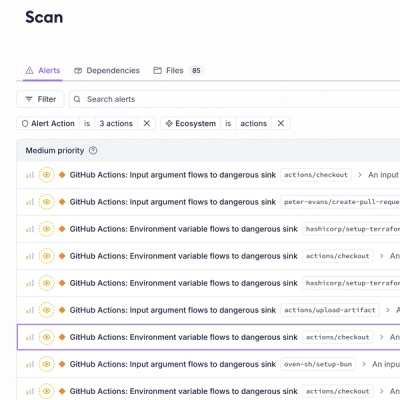
Product
Introducing Socket Firewall Enterprise: Flexible, Configurable Protection for Modern Package Ecosystems
Socket Firewall Enterprise is now available with flexible deployment, configurable policies, and expanded language support.
@laboratoria/fetch-gsheets
Advanced tools
fetch-gsheets is a command line tool used to retrieve data from Google
Spreadsheets.
Global install:
npm install --global @laboratoria/fetch-gsheets
# the same thing but using shortcuts ;-)
npm i -g @laboratoria/fetch-gsheets
As project devDependency:
npm install --save-dev @laboratoria/fetch-gsheets
# the same thing but using shortcuts ;-)
npm i -D @laboratoria/fetch-gsheets
Usage: fetch-gsheets [options] <selector-1> [...<selector-N>]
Command expects one or more "selectors" as arguments.
Each selector is a string with the following format:
'<spreadSheetId>!<sheetId>!<range>'
For example:
fetch-gsheets '2vG81bkFMfroZFNmCbD9SQcUo-Wed08goNrJB9Yyl9AB!SCL!A1:I'
In this example
* spreadSheetId: '2vG81bkFMfroZFNmCbD9SQcUo-Wed08goNrJB9Yyl9AB'
* sheetId: 'SCL'
* rangeL 'A1:I'
Options:
-c, --credentials Path to OAuth Client ID JSON file. Default: credentials.json
-h, --help Show this help.
-v, --version Show fetch-gsheets version.
For more info please check https://github.com/Laboratoria/fetch-gsheets
Before you use the fetch-gsheets command you will need to create a project
in the Google Cloud Console,
enable access to the Google Sheets API
for that project and create an OAuth Client ID. After creating a project in
Google Cloud and enabling access to the Google Sheets API, to get an
OAuth Client ID (the credentials for fetch-gsheets), follow these steps:
Go to https://console.cloud.google.com/apis/credentials.

Select Create credentials, then OAuth Client ID.

Pick other in the application type radio selector, give a name to the
client ID (something for you to remember what this client id is for) and
click on the Create button.

Dismiss the confirmation dialog after clicking

Finally click on the download button next to the newly generated OAuth 2.0 client ID in the list.

This file is expected to be an OAuth 2.0 Client ID. Something like:
{
"installed": {
"client_id":"557161231987-cjdfhbhatdov4idv3irt6js4jkv9248a.apps.googleusercontent.com",
"project_id":"your-amazing-project",
"auth_uri":"https://accounts.google.com/o/oauth2/auth",
"token_uri":"https://www.googleapis.com/oauth2/v3/token",
"auth_provider_x509_cert_url":"https://www.googleapis.com/oauth2/v1/certs",
"client_secret":"asd7123-abcbdyasd123ertg",
"redirect_uris":["urn:ietf:wg:oauth:2.0:oob","http://localhost"]
}
}
By default, fetch-gsheets will look for a file called credentials.json in
the current working directory (that is the directory from where
fetch-gsheets was invoked).
You can also specify a different path to the credentials file using the -c
(short version) or --credentials (long version) options.
fetch-gsheets \
-c ./path/to/oauth-client-id.json \
'2vG81bkFMfroZFNmCbD9SQcUo-Wed08goNrJB9Yyl9AB!SCL!A1:I'
fetch-gsheets \
--credentials ./path/to/oauth-client-id.json \
'2vG81bkFMfroZFNmCbD9SQcUo-Wed08goNrJB9Yyl9AB!SCL!A1:I'
When fetch-gsheets runs, it checks if an auth token already exists (in the same
dir as the credentials file - that's the OAuth Client ID JSON file). If it
does not exist, you will be prompted to authorize the app (the fetch-gsheets
command) as follows:
$ fetch-gsheets \
-c ./Downloads/client_secret_1234567890-abcdeovs2hetkgmpm4mui70283pth3a2.apps.googleusercontent.com.json \
'1Tviny8HzskBKP0HDKXoSClqyHsvQTO0XsWnyKWZGvJA!General!A1:H5'
Authorize this app by visiting this url: https://accounts.google.com/o/oauth2/v2/auth?access_type=offline&scope=https%3A%2F%2Fwww.googleapis.com%2Fauth%2Fspreadsheets.readonly&response_type=code&client_id=897165371071-hgj5qovs2hetkgmpm4mui70283pth3a2.apps.googleusercontent.com&redirect_uri=urn%3Aietf%3Awg%3Aoauth%3A2.0%3Aoob
Enter the code from that page here:
You should open the link in a web browser and follow the steps on the screen:
Finally, enter the token back in the console:
Enter the code from that page here: xxxxx
Token stored to /home/lupo/Downloads/token.json
[
// data goes here
]
Subsequent calls to fetch-gsheets will not prompt for authentication and will
run directly.
$ fetch-gsheets \
-c ./Downloads/client_secret_1234567890-abcdeovs2hetkgmpm4mui70283pth3a2.apps.googleusercontent.com.json \
'1Tviny8HzskBKP0HDKXoSClqyHsvQTO0XsWnyKWZGvJA!General!A1:H5'
[
// data goes here
]
NOTE: In the examples below we assume there is a credentials.json file with a
service account key in the directory where we are invoking fetch-gsheets. This
allows for no -c or --credentials options and thus simpler examples.
fetch-gsheets '2vG81bkFMfroZFNmCbD9SQcUo-Wed08goNrJB9Yyl9AB!SCL!A1:I'
fetch-gsheets \
'2vG81bkFMfroZFNmCbD9SQcUo-Wed08goNrJB9Yyl9AB!SCL!A1:I' \
'2vG81bkFMfroZFNmCbD9SQcUo-Wed08goNrJB9Yyl9AB!LIM!A1:I' \
'2vG81bkFMfroZFNmCbD9SQcUo-Wed08goNrJB9Yyl9AB!CDMX!A1:I'
fetch-gsheets \
'1xH90agOPuieIAAxSaP1IYx99-G64OP937GhHJs19q2O!SCL!B4:H60' \
'2vG81bkFMfroZFNmCbD9SQcUo-Wed08goNrJB9Yyl9AB!Sheet1!A1:I' \
'2vG81bkFMfroZFNmCbD9SQcUo-Wed08goNrJB9Yyl9AB!Sheet3!A1:X'
FAQs
Fetch Google Sheets from the command line
The npm package @laboratoria/fetch-gsheets receives a total of 141 weekly downloads. As such, @laboratoria/fetch-gsheets popularity was classified as not popular.
We found that @laboratoria/fetch-gsheets demonstrated a not healthy version release cadence and project activity because the last version was released a year ago. It has 5 open source maintainers collaborating on the project.
Did you know?

Socket for GitHub automatically highlights issues in each pull request and monitors the health of all your open source dependencies. Discover the contents of your packages and block harmful activity before you install or update your dependencies.

Product
Socket Firewall Enterprise is now available with flexible deployment, configurable policies, and expanded language support.

Security News
Open source dashboard CNAPulse tracks CVE Numbering Authorities’ publishing activity, highlighting trends and transparency across the CVE ecosystem.

Product
Detect malware, unsafe data flows, and license issues in GitHub Actions with Socket’s new workflow scanning support.